NOVA Air Scoop is an optimised air intake, which increases the internal wing pressure. NOVA's Air Scoop principle is similar to the ram-air inlet duct on a sports car: increased airflow produces higher pressure. Higher internal pressure in a paraglider means improved performance through increased structural stability and collapse resistance.
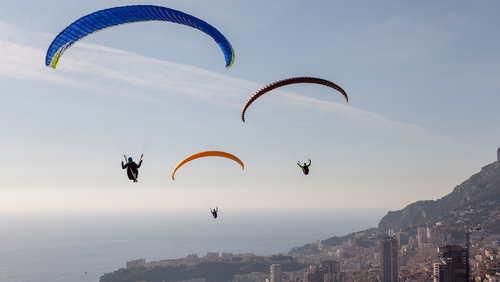 Flying with the Ion 3 in Monaco. Free for editorial use. Photo by Manuel Fasser
Flying with the Ion 3 in Monaco. Free for editorial use. Photo by Manuel FasserPerformance for all. The ION 3 is a big leap forward: it outperforms the Ion 2 by more than half a glide ratio point and even performs better than the MENTOR 2, which set the standard for cross country wings in the high-end EN-B class up to the end of 2012. How is this possible? Using increasingly sophisticated and comprehensive simulation software we are able to use the computer to make very detailed predictions as to how the wing will perform in the air. This allows us to manufacture simple wings with ever increasing performance. No other wing combines the characteristics of low aspect ratio, easy flight behaviour, performance and safety like the Ion 3. The Ion 3 offers unimaginable possibilities but at the same time it is remarkably gentle in its reaction to collapses. This is the reason we feel the Ion 3 is our most efficient paraglider so far: beginners, old hands, recreational pilots and cross country hounds can equally take advantage of this revolutionary concept. Simply, performance for all.
 Flying with the Ion 3 in Monaco. Free for editorial use. Photo by Manuel Fasser
Flying with the Ion 3 in Monaco. Free for editorial use. Photo by Manuel FasserEnjoy flying. Paragliders with a low aspect ratio are not only safer – they are more fun too. Why? Because of the greater turning moment and the large span, high aspect ratio can mean more demanding handling. And with a higher aspect ratio the chord is smaller and therefore the brake travel to the stall point is reduced. It is a fine art to match wing geometry to brake adjustment in such a way that safety and fun are in perfect harmony. With the Ion 3 we have achieved exactly that: long brake travel, but simultaneously it is agile and willing to turn when applying a small amount of brake, without being too demanding for the pilot. In comparison to the Ion 2, which set a number of standards in its class, the Ion 3 is the logical next step in our aim to combine performance with fun. Brakes that stay efficient even in lively thermic air were particularly important to our test pilots. The Ion 3 carves a smooth turn. It greedily bites into the turn even in the roughest thermal; at the same time it is even more stable in roll than its predecessor.
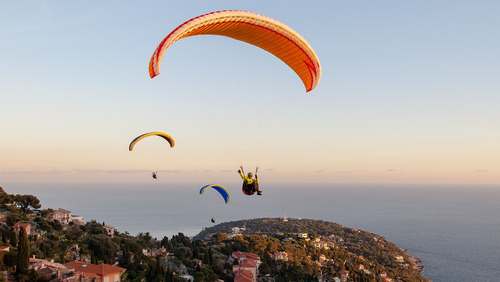 Flying with the Ion 3 in Monaco. Free for editorial use. Photo by Manuel Fasser
Flying with the Ion 3 in Monaco. Free for editorial use. Photo by Manuel FasserSimplicity and innovation. From our foundation it has been our mission to produce paragliders which are as simple, but also as powerful, as possible. In many ways simple ideas are an advantage, especially in the air. The reactions of the wing are more predictable. The pilot knows what to expect. The Ion 3 follows this tradition of innovative simplicity. It gains its advantages not primarily from increasing complexity, but from increased knowledge – in other words, real innovation. This includes our know-how in analysis and simulation processes, which permits us to better develop paragliders as a whole. One visible result of this analytical work is SmartCells, a new innovation in paragliding. The cells are of variable width, depending on their load. This has a positive impact on performance and handling. As already featured on the Mentor 3, the Ion 3 has double 3D-Shaping. Air Scoop was included in the Rookie and has been further developed to increase the internal pressure during accelerated flight – this increases performance and resistance to collapses. Therefore the Ion 3 is a big leap in progress.
Target group
 Flying with the Ion 3 in Monaco. Free for editorial use. Photo by Manuel Fasser
Flying with the Ion 3 in Monaco. Free for editorial use. Photo by Manuel FasserThe ION 3 is a paraglider suitable for a wide range of pilots. It offers a high degree of passive safety and is suitable for use in schools (so long as your country sanctions the use of EN B wings for training). On the other hand, its performance is impressive which makes the ION 3 a wing for all occasions: it is a fun wing which turns like a dream; a cross-country machine, tutor and gentle acrobat all in one. It is suitable for gifted beginners as well as experienced pilots with cross-country ambitions.
The ION 3 is a wing with high passive safety and at the same time it has a lot of performance. Simply, performance for all. Your Nova dealer will be delighted to advise on the correct wing!
Wings for flyweights
 Flying with the Ion 3 in Monaco. Free for editorial use. Photo by Manuel Fasser
Flying with the Ion 3 in Monaco. Free for editorial use. Photo by Manuel FasserAs with its predecessor, the ION 2, we wanted to produce an ION 3 in the XXS size, with a weight range beginning at 55kg. It was important to us not just to scale down a large wing, but to take into consideration the technical peculiarities of small wings. For example, our designers and test pilots modified the curvature of the wing and paid particular attention to ensuring that the XXS had a balanced and suitable brake configuration which matches the size of the canopy. Therefore the ION 3 XXS is more than just a scaled-down large wing. It is a wing with its own, fully-fledged specification. This allows women and lightweight men to enjoy a performance all-rounder. Even at the lower end of the weight range the ION 3 XXS shows its impressive agility. This is our contribution to equal opportunities in flying. Simply, performance for all.
Technology
Technical data
| XXS | XS | S | M | L | ||
|---|---|---|---|---|---|---|
| Number of cells | - | 49 | 49 | 49 | 49 | 49 |
| Projected span | m | 8,17 | 8,62 | 8,99 | 9,39 | 9,8 |
| Projected area | m² | 18,56 | 20,65 | 22,58 | 24,63 | 26,82 |
| Projected aspect ratio | - | 3,44 | 3,44 | 3,44 | 3,44 | 3,44 |
| Flat span | m | 10,61 | 11,19 | 11,73 | 12,25 | 12,78 |
| Flat area | m² | 22,1 | 24,59 | 26,99 | 29,44 | 32,06 |
| Flat aspect ratio | - | 5,09 | 5,09 | 5,09 | 5,09 | 5,09 |
| Line diameter | mm | 0,6 / 0,7 / 0,8 / 1,3 | ||||
| Line length | m | 6,22 | 6,56 | 6,89 | 7,18 | 7,49 |
| Total line length | m | 219 | 232 | 243 | 254 | 265 |
| Max. chord | m | 2,56 | 2,7 | 2,83 | 2,95 | 3,08 |
| Min. chord | m | 0,74 | 0,78 | 0,82 | 0,86 | 0,89 |
| Weight | kg | 4,9 | 5,3 | 5,7 | 6,1 | 6,5 |
| Recommended take off weight | kg | 55-80 | 70-90 | 80-100 | 90-110 | 100-130 |
| Certification (EN/LTF) | - | B | B | B | B | B |
Materials
| Leading edge: | DOKDO 30 DMF WR, 41 g/m2 |
|---|---|
| Top surface: | DOKDO 30 DMF WR, 41 g/m2 |
| Bottom surface: | DOKDO 30 DMF WR, 41 g/m2 |
| Profile ribs (with line suspension point): | DOKDO 30 DMF RIB, 41 g/m2 |
| Profile ribs (without line suspension point): | DOKDO 30 DMF WR, 41 g/m2 |
| Main lines: | Liros PPSL 160 (Dyneema) |
| Gallery lines: | Edelrid A8000-U90 (Aramid); Edelrid A8000-U130 (Aramid); |
| Brake lines: | Edelrid 7850-240 (Dyneema); Cousine 85 (Dyneema) |
| Risers: | Güth & Wolf Gurtband 20 mm |
服务
每一个NOVA滑翔伞都自动拥有一整套额外的服务与保障。当您购买伞具时,您获得的不只是产品本身¹。
在伞具使用初期,伞绳第一次经受真实飞行状态的考验。不管使用哪一种伞绳材料,这个阶段伞绳都可能发生拉伸或缩短。通过NOVA Trim Tuning²(NTT伞形修正),我们用软件对伞具变形进行分析,测算出需要修正的参数。伞形修正既确保伞具安全,又提升飞行乐趣。
购买伞翼并成功将它在myNOVA注册后,您将获得一整年的全面保险(扣除:63.50欧元,包括增值税 /+邮费和包装费³)。您造成的破损,我们来买单。“NOVA保护”意味着您可以专注于重要的事情:飞行本身!如果您把伞弄坏了,我们来维修。
“NOVA全服务”不只是一次检查。就像“NTT伞具修正”一样,我们分析伞绳长度,以确保整个伞翼都被调整到了最佳伞形状态。这是对伞翼的一次全面健康体检。我们的“NOVA全服务”让您对爱伞充满信心。
如果您的伞接受过“NTT伞具修正”服务,下一次检查的时间就从两年延长到了三年。满两年的检查相应地变成满三年检查。这让您拥有多一年的无忧飞行。但请注意伞具说明书里规定的最大飞行小时数。
标准情况下,NOVA提供三年而非两年的保修。如果您的伞有接受“NTT伞具修正”和“NOVA全服务”的话,我们将把保修期再延长一年。让您飞NOVA伞飞得开心。
如果您在myNOVA注册您的伞,它就加入到了我们的“质量保障数据库”。在这个数据库里——登陆myNOVA——您可以下载关于您的伞的所有关键数据。这个数据库也会帮助工作人员能够方便快捷地“一键”了解您的伞。您的爱伞也将得到更全面的“体检”。
1 受条件限制,保修及服务在不同国家的提供情况有所区别,详细信息可查看我们的保修条款。
2 此服务包含在选定国家/地区的购买价格中。更多相关信息,请联系您的经销商。
FAQ
Where the glider is flown in the weight-range is first and foremost a question of personal preference: anyone seeking a high degree of agility and dynamic flying should fly our wings at the higher end of the weight-range. Pilots who are happier with gentle flights with a high degree of damping will be happier in the middle of the weight-range. Of course, the flying conditions have a big influence - in turbulent, windy conditions greater wing loading will bring greater stability; whereas flying the glider at the lower end of the weight-range makes it unbeatable in weak thermals. Correct wing loading is mainly a question of personal preference and the conditions in which you mainly fly. Your Nova dealer will be happy to advise you!
The brakes are components relevant to certification - modification can affect the flying characteristics and extreme flight behaviour. Because of this, we strongly advise against any modification of the brake system. It is important that the brake has sufficient travel before it engages. This is also important so that the wing does not brake automatically when the speed bar is used. Furthermore a brake that engages too early affects performance and influences the recovery during incidents, for example during a collapse or when the canopy goes parachutal.
Performance data depends heavily on the drag created by the pilot and this is linked to their seating position and harness type. An aerodynamic harness or seating position can make the difference of one glide ratio point. We at NOVA never determine absolute performance data, instead we make comparisons with reference gliders. For this reason we do not publish performance data.
The way a pilot holds the brake handles is a matter of personal preference - but it does have significant influence on the handling and flying characteristics of the wing. We recommend a half-wrap. You hold the brake handle in your palm and twist it half way around your hand so that the brake line lies between your thumb and forefinger. This shortens the brake travel by approximately 20 centimetres and this has a positive effect on feedback - firstly you directly feel the travel of the brake line and secondly, with the arms positioned higher, it is easier to feel the wing. The exception is of course when gliding or during other phases of the flight when steering with the brake is not necessary. Please note: when changing from no-wrap to half-wrap, the shortened brake travel must be taken into consideration.
The ION is less dynamic than the MENTOR. The ION is suitable for pilots desiring more comfort and a more relaxed feel while in the air. In comparison, the MENTOR is sportier.
Simplicity is our motto. Our wings can be packed using a concertina bag, but it is not essential. You can fold this wing using your preferred method and pack it in our stuff sack. Be careful not to bend the leading edge rods unnecessarily. This is particularly true if the wing is to be stored for longer periods or if it is packed tightly.
Sail cloth, lines and all other components are subjected to rigorous testing before they are used in serial production. We not only test the sail cloth for durability (high porosity or reduced tear resistance through UV damage or wear) but also for mechanical robustness, for example stretching. For quality control purposes we regularly take samples during serial production.
During the initial flights the lines are first subjected to load. This load induces a small degree of stretching and shrinking. These are not associated with the line manufacturers or the quality of workmanship - in the factory all NOVA paragliders are trimmed and pre-stretched to within a very low tolerance. To adjust this stretching or shrinking, we recommend that the wing is taken for NTT (NOVA Trim Tuning) after ten to twenty flights - after one year at the very latest. Generally, the line lengths remain constant after the first ten to twenty hours. To make full use of the NTT, NOVA encourages all pilots to have their wing checked after ten to twenty flying hours.
Dry, not packed too tightly and if possible in a space without wide temperature variations - these are the conditions that make our paragliders feel well. You should never store a wing when it is moist. You should also avoid excessive heat, like you would have, for example, in the car. Never remove dirt using chemical detergents and/or brushes.


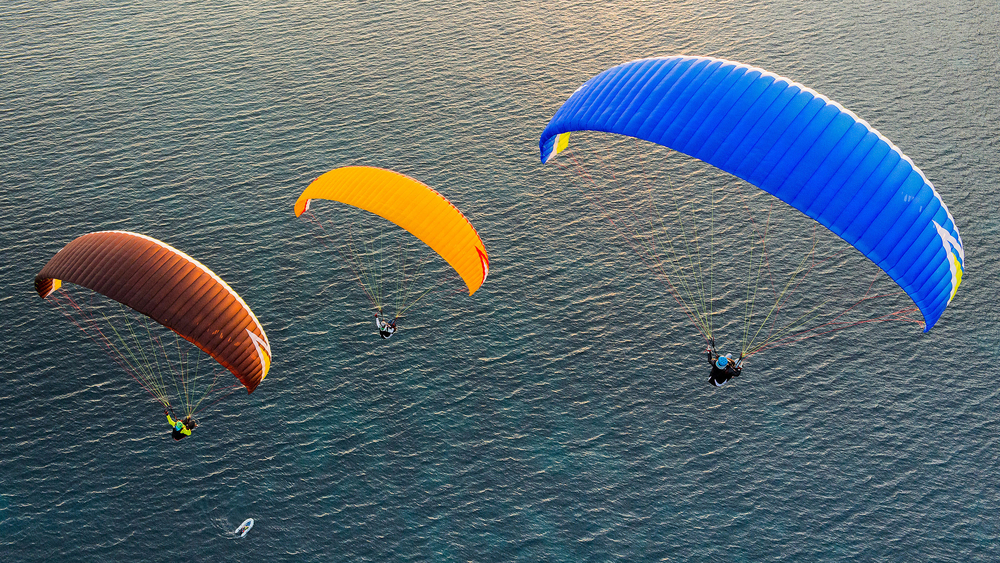

 Blue
Blue Brown
Brown Gold
Gold







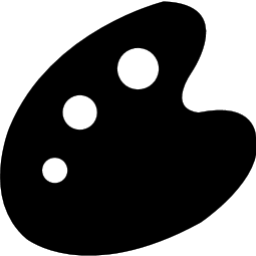

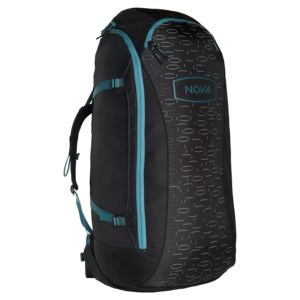 NOVA Rucksack.
NOVA Rucksack.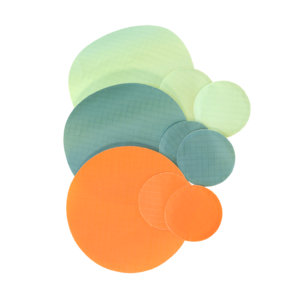 Repair kit.
Repair kit.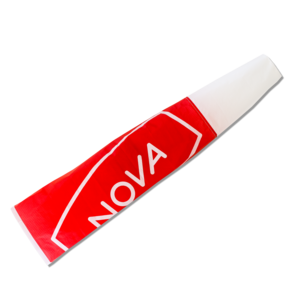 NOVA windsock.
NOVA windsock. Speed system.
Speed system.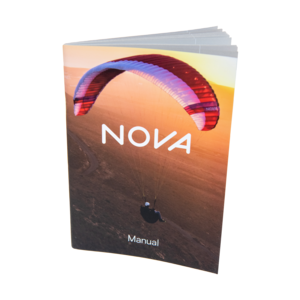 Manual.
Manual.